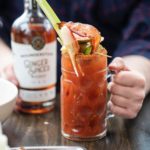In 2015, one of the first mainstream attempts was made at incorporating pineapple in rum. The spirit was called Plantation Stiggins’ Fancy, a rum that’s soaked and distilled with pineapple.
This rum was released by a brand named Maison Ferrand. The rum itself is named after Reverend Stiggins, a character out of Charles Dickens’s “The Pickwick Papers.” As a drinker himself, Dickens commonly created characters that indulged in alcohol, but none were more distinct than Reverend Stiggins. This character was a religious hypocrite who advocated for temperance while drinking pineapple rum.
The spirit of this fictitious character inspired a brand new style of rum. But despite being macerated and purified in pineapple, Plantation Stiggins’ Fancy doesn’t taste particularly like pineapple. You could taste its subtle notes, but it’s far from a pineapple-flavored rum.
Before the success of the Plantation Stiggins’ Fancy, pineapple rum was hardly a real concept. However, that would all change in the coming years, as several new producers started rolling out their own pineapple-inspired rums.
So, what’s Pineapple Rum?
Pineapple rum is delicious on its own, but it’s also great for cocktails like Daiquiris, tikis, and many more. It can be enjoyed on a hot summer day or on a chilly winter evening. With its depth and complexity as a spirit, pineapple rum is extremely versatile.
Most people don’t know that pineapple in rum has existed for as long as 300 years. Dating back to the late 1700s, distillers on the Caribbean islands would soak their rum in pineapple while in the barrel. This technique injected the rum with some extra sweetness and richness.
Today, producers have taken the inspiration to an entirely new level, creating rums that are actually flavored with pineapple. For a complete history lesson on pineapple rum, keep reading below with Saucey.
A deep history of Pineapple Rum
We’ve seen the mango rum trend. And we’ve seen the orange rum trend. But now, it’s time for pineapple.
As mentioned before, pineapple-distilled rum has existed for centuries. Originally, it was used to correct the early recipes of rum, which lacked sweetness. It struggled to take off on the islands, but it became a favorite among the English.
You can even find newspaper advertisements from the 18th and 19th centuries advertising pineapple-distilled rum. All of this rum was being exported from the Caribbean.
In London, one of the most prominent rum warehouses ever was developed. It was known as the Rum Quay. The vaults in this warehouse carried up to four million imperial gallons of overproof bonded rum, which equated to over 18 million liters.
To give you a better picture of how much rum this is, if diluted to 40% ABV, this much rum would fill up over 48 million of the standard 750 mL bottles we see today.
The production process for pineapple-distilled rum in the Rum Quay was simple. To start, the juice was extracted from the pineapple with a press. Next, the rum is soaked in the pressed pulp for multiple weeks. Before being casked or bottled for export, the pineapple-infused rum and pulp are thrown into blending vats with normal rum.
How is Pineapple Rum made today?
Back then, they used to distill their rum with pineapple. It’s a completely different result when you actually make the rum with pineapple.
Producers in the 18th and 19th centuries would soak their rums in pineapple after they were already made. But today, just how grapes are used to create the base for wine, pineapples are being used to create the base for rum.
Both the flesh of the fruit and its skin can be used to make rum. First, the fruit and the skin are submerged in rum. Depending on the recipe, they could be put in an additional type of rum after the first one.
The infusion process could take up to three months. The ingredients are aged in casks. Finally, the rum is ready to be made. The next step is to blend the pineapple and its skin with fermented sugar cane, creating the spirit’s base.
The rum may then be distilled in pineapple, further pushing the tangy fruit’s notes into the mixture. Finally, it is aged in a cask before being bottled. Some rums can be aged for up to twenty years.
Though this rum is usually aged in a rum cask, some producers opt for a second aging process in a Cognac cask.
Some producers are also adamant about only using Victorian-style pineapples. These giant-sized pineapples are the size of a bowling ball.
Cognac & Rum: a beautiful blend
You can find many similarities between cognac and rum. They are both distilled spirits and have a semi-dark to dark appearance. They both float around the 40% ABV mark. Where these two spirits really share similarities is in how they’re made.
When the entrepreneurial Frenchman Alexandre Gabriel started the Maison brand, he set his sights on producing premium, quality cognac. Little did he know that he was going to introduce a revolutionary style of rum to the industry.
For decades, Maison Ferrand focused solely on cognac, and they did an amazing job at it. Within a few years, they gained a reputation as one of the premiere Cognac houses in the world.
Gabriel has always had an interest in how the Caribbean natives mature their rum. It was a process similar to maturing cognac, which intrigued Gabriel. Maison Ferrand even produced some bottles of cognac in the Caribbean.
It was only a matter of time before Gabriel began producing rum. Using his knowledge of wooden cask aging, he was able to invent the Plantation Stiggins’ Fancy.
When speaking about making rum, Gabriel says, “I thought quite humbly that I could bring my Cognac experience to rum. They are very different, but they are also quite similar.”
How does Pineapple Rum taste
So what does pineapple rum taste like? Imagine a sweet, subtly fruity rum with perfect smoothness and a light finish. It tastes more sugary than your typical rum, but it isn’t overbearing.
Pineapple rum is an awesome cocktail ingredient because of how balanced of a spirit it is. It’s sweet but deliciously strong. It’s thick but not syrupy. This style of rum is ideal for both simple, straightforward cocktails and complicated ones.
Depending on what type of rum is used to macerate the pineapples, you may also taste hints of a different rum, like white rum or spiced rum. The scent of your pineapple rum will also be affected by what kind of rum was used.
Other ingredients you may taste in your pineapple rum include soft brown sugar, nutmeg, and cinnamon. You may also taste some additional sweetness if the pineapples in your rum were roasted or candied.
Pineapple provides freshness and sharpness that few other fruits can provide. It’s citrusy. It’s tropical. And it is oh-so-good.
For a long time in the industry, flavored rums weren’t all that great. Many of them were cheaply flavored, lacked density, and were overly sweet. This rise of pineapple rum has changed the narrative on flavored rums, proving that a fruity rum can, in fact, be elegant and high-quality.
Now, there is a legit production process behind flavored rum, and we’re definitely going to be seeing more renditions of this drink in the years to come.
The takeaway
Since Plantation Stiggins’ Fancy, we have seen several brands try to jump in on the pineapple rum craze. From Bacardi to Captain Morgan to Malibu and Cruzan, it seems that all the rum brands are hopping on the bandwagon.
In recent months, a slew of new pineapple rums has hit the markets. This style of rum has hit the shelves of hundreds of liquor stores in the country, and it continues to make its way across the globe.
No longer is rum an old man’s drink or a measly component of mixed drinks. Rum is a standalone hero now. No longer does it lurk in the shadows behind its distilled counterparts, whiskey and gin.
Flavored and spiced rums now make up over 55% of rums sold in the world. Besides pineapple rum, drinkers can also enjoy citrus, raspberry, vanilla, and others.
If you’re looking for some quality pineapple rum, check out Saucey. We offer over a dozen different types of pineapple rum from a variety of brands. We also carry other spirits, as well as beers, wines, and other alcohol-related products.


